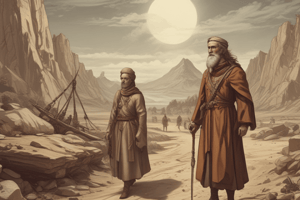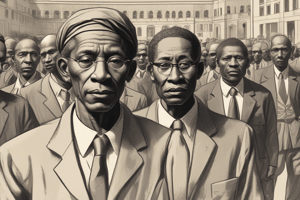Podcast
Questions and Answers
Which group relied heavily on livestock herding for survival?
Which group relied heavily on livestock herding for survival?
- Tribes
- Indigenous peoples
- Settled communities
- Nomads (correct)
What was a key factor contributing to the success of nomads in navigating demanding environments?
What was a key factor contributing to the success of nomads in navigating demanding environments?
- Permanent settlements
- Technological advancements
- Isolation
- Adaptability (correct)
What characterized the cultural practices of tribal peoples?
What characterized the cultural practices of tribal peoples?
- Nomadic lifestyle
- Connection with natural surroundings (correct)
- Preference for urban living
- Reliance on advanced technology
Which group is described as leading a life of constant movement?
Which group is described as leading a life of constant movement?
What distinguished nomads from settled communities and tribes?
What distinguished nomads from settled communities and tribes?
Which aspect is highlighted as key to human progression based on the text?
Which aspect is highlighted as key to human progression based on the text?
What is a key characteristic of tribes?
What is a key characteristic of tribes?
Which of the following was a primary source of food for members of tribal societies?
Which of the following was a primary source of food for members of tribal societies?
What distinguished settled communities from tribes?
What distinguished settled communities from tribes?
How did nomadic peoples differ from settled communities?
How did nomadic peoples differ from settled communities?
What was a common feature of tribal societies?
What was a common feature of tribal societies?
How did settled communities contribute to population growth and societal complexity?
How did settled communities contribute to population growth and societal complexity?
Flashcards are hidden until you start studying
Study Notes
Exploring Human History through Tribes, Nomads, and Settled Communities
Throughout humanity's evolutionary journey, diverse ways of living have emerged, each reflecting unique adaptations to the environment and cultural preferences. From tribal societies rooted deep within history to nomadic peoples who wander freely across landscapes, this exploration will shed light on these distinct yet intertwined facets of our past.
Tribes
Tribe is arguably one of the earliest forms of human social organization. A tribe consists of people sharing common ancestry, culture, customs, beliefs, and territories. As hunter-gatherer societies, members of tribes often lived closely with nature, following seasonal food sources like wild fruits, game animals, fish, and plants. Life was communal; everyone contributed according to their skills and abilities while relying upon established rituals and traditions passed down from generation to generation.
Settled Communities
With the growth of agriculture and development of permanent settlements, humans began establishing settled communities where they could cultivate crops and build homes. These advancements allowed for population density increases, leading to specialization of labor and more complex socioeconomic systems. While some elements of tribal life remained intact, new challenges and opportunities emerged as people adapted to intricate societal structures and hierarchical arrangements.
Lifestyle of Nomads
In contrast to both tribes and settled communities, nomads led a life of constant movement, seeking out resources such as water, grazing land, and hunting grounds over vast expanses of terrain. Relying heavily on livestock herding—such as camels, yaks, horses, or cattle—nomads migrated to follow seasonal patterns, ensuring the survival and wellbeing of themselves and their herds. Although many nomadic groups maintained close ties to local communities and traditions, adaptability was key to their success in navigating deserts, steppes, grasslands, and other demanding environments.
Cultural Heritage of Tribes
The native cultures developed by tribal peoples were often deeply connected to their natural surroundings. Indigenous practices reflected the ecosystems they inhabited, incorporating spiritual, religious, and practical knowledge handed down through generations. For example, Native American tribes revered Earth Mother figures, while Mongolian shamans honored the spirits of rivers, mountains, and animals. Similarly, Maasai warriors celebrated ancient rites during ceremonial dances and festivals.
Conclusion
As society evolved, so did its reliance upon various living arrangements. Though each has its own story embedded within history, we can see how all three forms – tribes, nomads, and settled communities – have shaped modern civilization. By exploring these distinct modes of existence, it becomes evident that human progression stems from mutual cooperation, adaptive solutions, and respectful coexistence between different lifeways.
Studying That Suits You
Use AI to generate personalized quizzes and flashcards to suit your learning preferences.




